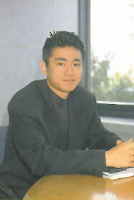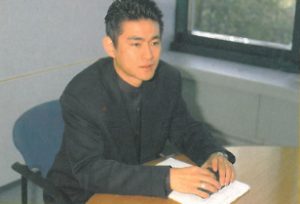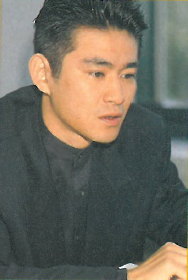This interview first appeared in the January 1996 issue of the Spanish video game magazine, Ultima Generacion, an equivalent of Next Generation magazine. In it, Sega AM3 Producer Tetsuya Mizuguchi talks about porting the arcade hit Sega Rally to the Saturn and the challenges involved. He also shares a bit about AM3’s upcoming arcade game, Manx TT.
* * *
 This past December 2, Madrid was visited by Tetsuya Mizuguchi, one of the most important names in the AM3 R&D group and the person most responsible for the relevance and weight of Sega Rally. In Tetsuya Mizuguchi’s tour of different European cities, Spain was selected as his first destination. After stopping in our country, he continued to Italy, where he had the opportunity to visiting Lancia’s headquarters to express thanks for the legendary auto company’s collaboration in the development of Sega Rally.
This past December 2, Madrid was visited by Tetsuya Mizuguchi, one of the most important names in the AM3 R&D group and the person most responsible for the relevance and weight of Sega Rally. In Tetsuya Mizuguchi’s tour of different European cities, Spain was selected as his first destination. After stopping in our country, he continued to Italy, where he had the opportunity to visiting Lancia’s headquarters to express thanks for the legendary auto company’s collaboration in the development of Sega Rally.
Within his busy schedule, which included a visit to the Divercor Family Entertainment Center, we had a chance to share some time with him at Sega Spain’s headquarters in Madrid. Tetsuya spoke about the present and the future of his development group and made known his qualified impressions about the Saturn.
Ultima Generación: How did the process of porting Sega Rally from the Model 2 to the Saturn begin?
Tetsuya Mitzuguchi: First of all, we need to clarify the term “port.” At no time was the Saturn version of Sega Rally a port. We had to develop code that was completely new and separate from the original Model 2.
Ultima Generación: Technologically speaking, did the machine’s design pose any problems in this process?
Tetsuya Mitzuguchi: Less than imaginable at first. It must be noted that technologically, the Saturn is a very high quality machine and can thus offer many equally important benefits. To name an example: the Model 2, when it’s time to do texture mapping, only supports monochrome characters, a problem that was solved by the Saturn hardware (thank God), which made the use of true color (millions of colors) possible.
Ultima Generación: One of the notable aspects of the game might be how realistically the cars behave. How did you achieve this effect?
Tetsuya Mitzuguchi: For the development of Sega Rally, we spent hundreds of hours testing the cars and their behavior. In fact, the biggest problem we had was with handling of the third car, the Lancia Stratos, a vehicle which I, particularly, had never driven. To accurately recreate that car’s handling, we turned to expert drivers who advised us about its behavior on different terrain. Similarly, for the development of Manx TT, we maintain direct contact with companies like Honda with the goal of achieving a greater degree of simulation.
Ultima Generación: Sega Rally’s two-player mode is perhaps the most successful we’ve seen so far. What’s the secret of this wonderful result?
 Tetsuya Mitzuguchi: When it came time to discuss the possibility of including a mode where two players could compete simultaneously, we opted to do it directly, without cables or the need to connect two consoles, two televisions, and two games, which is what happens with other game consoles. This decision brought with it the logical division of game elements, like polygons, by half. Evidently, we chose to remove the most expendable elements, like trees, people, and other strictly decorative things, with the goal of respecting how truly transcendent the cars and their behavior were.
Tetsuya Mitzuguchi: When it came time to discuss the possibility of including a mode where two players could compete simultaneously, we opted to do it directly, without cables or the need to connect two consoles, two televisions, and two games, which is what happens with other game consoles. This decision brought with it the logical division of game elements, like polygons, by half. Evidently, we chose to remove the most expendable elements, like trees, people, and other strictly decorative things, with the goal of respecting how truly transcendent the cars and their behavior were.
Ultima Generación: Could Sega Rally can be considered the high-water mark of what the Saturn has to offer?
Tetsuya Mitzuguchi: Completely the opposite. At this moment, we could say that we’re still in a learning period, and that Sega Rally is only the tip of the iceberg of what the Saturn can offer.
Ultima Generación: Earlier, you mentioned the new game you’re working on, Manx TT. Has its development presented challenges similar to what you experienced with Sega Rally?
Tetsuya Mitzuguchi: Manx TT is a new concept, completely different from everything we’ve done until now. Its development has presented a greater number of problems than Sega Rally’s did. You must remember that the vehicles in the latter were square boxes, and thus far easier to move than the motorcycles in Manx TT that, aside from their more complicated physical form, include a human rider with all his movements. Similarly, the competitive mode, with [up to] eight simultaneous players, also makes our job considerably more difficult.
Ultima Generación: What new options does Manx TT have?
Tetsuya Mitzuguchi: First, and different than what happened with Sega Rally, where the driving was static, Manx TT offers movement, with turns that become spectacular drifts. Another important point that decidedly contributes to the experience is the sound. The game has four audio outputs that produce an exciting immersive effect for the player. We’ve included real sound in the tailpipe that, together with the ability to put you feet on the pedals, create a tremendously real simulation effect.
Ultima Generación: From your point of view as a member of one of the principal entertainment software development groups, what goals should a game meet to be successful?
Tetsuya Mitzuguchi: At Sega, when it’s time to make games, we always keep four fundamental and concrete points. First, our games should produce a sensation of intoxication, like you’d feel at a rock concert, in which the environment wraps up the player. Second, they must lend themselves to competition. The third point is to include a fair and necessary amount of simulation, without excess. Finally, they have to provoke tension and emotion in those who play them.
Ultima Generación: In your opinion, where is the future of video games? Could it be in virtual reality?
 Tetsuya Mitzuguchi: Absolutely not. Video games shouldn’t present reality exactly as it is and should instead adapt it to offer what’s really important: fun [a word Mitsuguchi used constantly throughout our talk]. In this sense, I can share a notably explicit personal experience. On one occasion, I had the opportunity, together with a friend, to try a real combat simulator. After a long period of dull flying in search of my opponent, all the contact we had was reduced to one supersonic encounter. My friend’s plane passed right over mine before I barely had time to see it. Then, we went back to bland flying. Evidently, that’s real, but in no way is it fun. The public wants to have quick an easy access to a foe, maintaining the right dose of realism.
Tetsuya Mitzuguchi: Absolutely not. Video games shouldn’t present reality exactly as it is and should instead adapt it to offer what’s really important: fun [a word Mitsuguchi used constantly throughout our talk]. In this sense, I can share a notably explicit personal experience. On one occasion, I had the opportunity, together with a friend, to try a real combat simulator. After a long period of dull flying in search of my opponent, all the contact we had was reduced to one supersonic encounter. My friend’s plane passed right over mine before I barely had time to see it. Then, we went back to bland flying. Evidently, that’s real, but in no way is it fun. The public wants to have quick an easy access to a foe, maintaining the right dose of realism.
Ultima Generación: To conclude, can you tell us anything about any future AM3 projects?
Tetsuya Mitzuguchi: Evidently, there are a lot of projects. However, we’re not going to reveal anything until Manx TT is completely finished and ready to be played.

Recent Comments